| 2022: Get Ready for two Lunar Eclipses (2022-1-04) ⬅︎ |
 |
Eclipses all involve the interplay between sun, earth and moon as the moon orbits the earth and the earth orbits
the sun. About every six months, during times known as eclipse seasons, these worlds can line up just right so that
eclipses can be viewable from certain places on earth. In 2021, eclipse seasons will occur in May and November
and we will be experiencing a lunar eclipse in each.
A lunar eclipse is an event in which the moon travels through the earth's shadow often taking hours. It is important
to note that there are two parts to the earth's shadow:
* penumbra (almost shadow in Latin) is the outer part of earth's shadow.
* umbra (shadow in Latin like the word umbrella) is the inner part of earth's shadow.
When the moon enters the penumbra, it will become a dark gray. But when the moon enters the umbra, it
will turn deep red. Why red? It is due to the light from the sun skimming through the earth's atmosphere, being
turned red in the process. It is a projection of all of earth's sunrises and sunsets onto the moon. And it is for this
that the moon when traveling through the umbra is called a blood moon.
May 15: Total Lunar Eclipse
On the evening of May 15 we will be experiencing a total lunar eclipse. The bad news is that about half of the
eclipse will be over
by the time the Moon rises and becomes visible in our sky. Boo! The good news is that we'll still be able to view
about one hour of
totality before the Moon begins to pull out of Earth's shadow. Yay!
Key Events for the Starry Hill region
* 6:32 PM
The moon enters the penumbra and begins to darken. The eclipse has begun.
* 7:28 PM The
moon enters the umbra and begins to turn red.
* 8:29 PM
Totality starts -- the moon is totally red.
* 8:32 PM Moonrise. Sunset is at 8:38.
* 9:54 PM
Totality ends
-- the moon is no longer totally red.
* 10:55 PM The moon exits the umbra and is dark but no longer red.
* 11:51 PM The moon exits the penumbra ending the eclipse.
November 8: Total Lunar Eclipse
On the morning of November 8 we will be experiencing a total lunar eclipse. The bad news is that the eclipse will
start around
midnight and end around 6 AM. Boo! The good news is that we'll be able to view the entire eclipse from start to
finish. Yay! If you
just want to catch totality, watch the hour 2:30-3:30 AM.
Key Events for the Starry Hill region
* 12:02 AM
The moon enters the penumbra and begins to darken. The eclipse has begun.
* 1:08 AM The
moon enters the umbra and begins to turn red.
* 2:17 AM
Totality starts -- the moon is totally red.
* 3:42 AM
Totality ends
-- the moon is no longer totally red.
* 4:49 AM The moon exits the umbra and is dark but no longer red.
* 5:56 AM The moon exits the penumbra ending the eclipse.
|
| |



